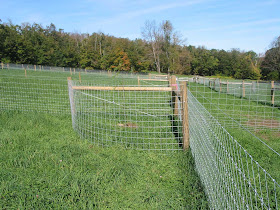

Our pasture system is not a regular rotational grazing system. We've also integrated a medicinal hedgerow and some sylvopasture research experiments. Sylvopasture combines pasture and livestock production with trees. The trees we're using are mostly Ashworth Honey Locust trees. They are a variety developed before chemical fertilizers when the USDA was looking for high protein livestock feed options. These honey locust bear seeded pods that can be fed to sheep, goats and chickens. The leaves can be fed to livestock and they are a nitrogen-fixing tree so their roots will nourish the pasture grass growth. Not only that but their leaves are finely cut compound leaves that will not cast a dense shadow and not smother grasses when they fall. We'll be growing some of these full size and also experimenting with coppicing some of them. Coppicing means cutting the tree down and letting suckers grow from the stump to harvest on a schedule determined by the size of growth that best suits your needs.
Our medicinal hedgerow experiment consists of a 6 foot alley pasture between 2 other pastures. This is being planted with herbs that, once they grow enough to stick into the pasture on each side, will be available for grazing by flocks. I'll be doing research on what immune boosting, deworming, etc. herbs are helpful. For now there are gingko and sea buckthorn planted down the center. Both produce palatable nourishing fruit.
Our fencing system also includes some areas that aren't meant to be grazed but are food production areas that the dogs will be able to guard against fruit predators such as bear, raccoon, etc. We have Russian quince, persimmon pear and mulberry so far. We'll be adding some apples and persimmons trees from our nursery beds once it's a good season for transplanting.
We've put honey locust trees into corners of many of our rotational grazing plots. We've protected them with livestock panels that are attached to the corner brace fence posts using eye-hooks and re-bar. You can see it in the photos.
Holy smokes - what a great plan!
ReplyDeleteThanks! Still a lot of planting to do but it'll come together over time. I probably should plant a lot of raspberries in there since raspberry leaf is such a good pregnancy tonic.
ReplyDeletePlease tell me you'd be willing to cut some scionwood this winter and sell it. These improved honey locust cultivars are almost impossible to find.
ReplyDeleteI'd be happy to pay 4$ a piece plus shipping, as many pieces as you were willing to sell.
Of the Ashworth specifically [and Millwood or Hershey or Calhoun if you happened to have them as well.]
DeleteHi Luke, can you contact me by email? We can exchange phone numbers that way and then connect by phone. I'd be glad to talk about this. There are 2 other folks in my area working with Ashworth Honey Locust and one of them is doing some grafting and has more experience than I at cutting scion wood. my email address is kathrin at foxmountain dot net Or look for my contact at my farm website www.sovereignhillfarm.com I look forward to connecting.
DeleteThis comment has been removed by a blog administrator.
ReplyDelete